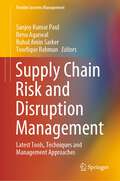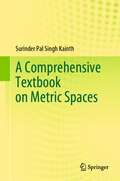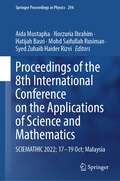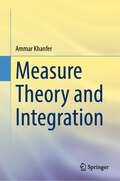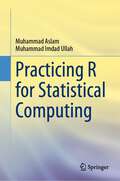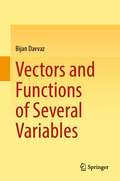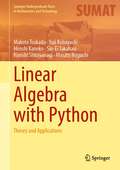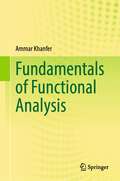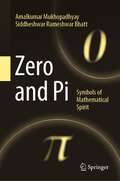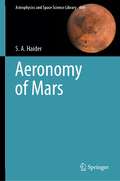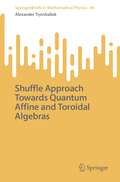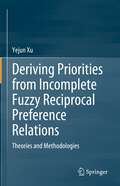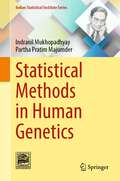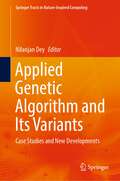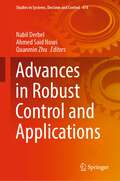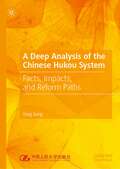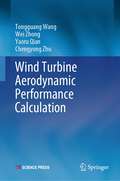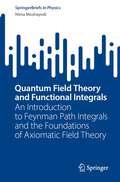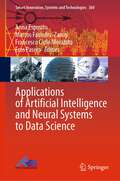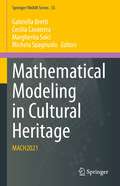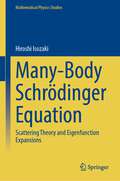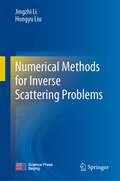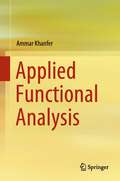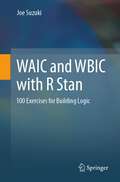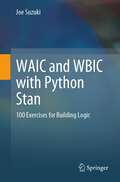- Table View
- List View
Supply Chain Risk and Disruption Management: Latest Tools, Techniques and Management Approaches (Flexible Systems Management)
by Sanjoy Kumar Paul Renu Agarwal Ruhul Amin Sarker Towfique RahmanIn this book, a risk management approach starts off by discussing important issues related to managing supply chain disruption risks from various perspectives during VUCA times. It explores the essence and principles relating to managing these risks and provides the framework and multi-goal model groups for managing such unknown-unknown risks and subsequent disruptions at a global scale.The book explores and presents the latest developments across different emerging topics in supply chain risk and disruption management. These include (i) an overview of supply chain risk, and disruption management tools, techniques, and approaches, (ii) a review on uncertainty modeling for decentralized supply chain systems, (iii) supply chain deep uncertainties and risks - the 'new normal', (iv) emergent technologies for supply chain risk and disruption management, (v) supply chain resilience strategies for times of unprecedented uncertainty, (vi) the role of blockchain in developing supply chain resilience against disruptions, (vii) a qualitative study on supply chain risk management adopting blockchain technology, (viii) assessment of risks and risk management for agriculture supply chain, (ix) resilience of agri-food supply chains: Australian developments after a decade of supply and demand shocks, (x) prioritization of risks in the pharmaceutical supply chains (xi) improving medical supply chain disruption management with the blockchain technology, and (xii) impacts of resilience practices on supply chain sustainability.The book contributes significantly to the growing body of knowledge concerning the theory and practice of managing supply chain risks and disruptions in strategic management, operations and supply chain, and sustainability literature. It presents contemporary, innovative and latest developments in applying smart management tools, techniques and approaches for managing supply chain risk and disruption and future-proofing supply chains to become agile, resilient and sustainable.
A Comprehensive Textbook on Metric Spaces
by Surinder Pal KainthThis textbook provides a comprehensive course in metric spaces. Presenting a smooth takeoff from basic real analysis to metric spaces, every chapter of the book presents a single concept, which is further unfolded and elaborated through related sections and subsections. Apart from a unique new presentation and being a comprehensive textbook on metric spaces, it contains some special concepts and new proofs of old results, which are not available in any other book on metric spaces. It has individual chapters on homeomorphisms and the Cantor set. This book is almost self-contained and has an abundance of examples, exercises, references and remarks about the history of basic notions and results. Every chapter of this book includes brief hints and solutions to selected exercises. It is targeted to serve as a textbook for advanced undergraduate and beginning graduate students of mathematics.
Proceedings of the 8th International Conference on the Applications of Science and Mathematics: SCIEMATHIC 2022; 17—19 Oct; Malaysia (Springer Proceedings in Physics #294)
by Aida Mustapha Norzuria Ibrahim Hatijah Basri Mohd Saifullah Rusiman Syed Zuhaib Haider RizviThis book presents peer-reviewed articles and recent advances on the potential applications of Science and Mathematics for future technologies, from the 8th International Conference on the Applications of Science and Mathematics (SCIEMATHIC 2022), held in Malaysia. It provides an insight about the leading trends in sustainable Science and Technology. Topics included in this proceedings are in the areas of Mathematics and Statistics, including Natural Science, Engineering and Artificial Intelligence.
Measure Theory and Integration
by Ammar KhanferThis textbook contains a detailed and thorough exposition of topics in measure theory and integration. With abundant solved examples and more than 200 problems, the book is written in a motivational and student-friendly manner. Targeted to senior undergraduate and graduate courses in mathematics, it provides a detailed and thorough explanation of all the concepts. Suitable for independent study, the book, the first of the three volumes, contains topics on measure theory, measurable functions, Lebesgue integration, Lebesgue spaces, and abstract measure theory.
Practicing R for Statistical Computing
by Muhammad Aslam Muhammad Imdad UllahThis book is designed to provide a comprehensive introduction to R programming for data analysis, manipulation and presentation. It covers fundamental data structures such as vectors, matrices, arrays and lists, along with techniques for exploratory data analysis, data transformation and manipulation. The book explains basic statistical concepts and demonstrates their implementation using R, including descriptive statistics, graphical representation of data, probability, popular probability distributions and hypothesis testing. It also explores linear and non-linear modeling, model selection and diagnostic tools in R. The book also covers flow control and conditional calculations by using ‘‘if’’ conditions and loops and discusses useful functions and resources for further learning. It provides an extensive list of functions grouped according to statistics classification, which can be helpful for both statisticians and R programmers. The use of different graphic devices, high-level and low-level graphical functions and adjustment of parameters are also explained. Throughout the book, R commands, functions and objects are printed in a different font for easy identification. Common errors, warnings and mistakes in R are also discussed and classified with explanations on how to prevent them.
Vectors and Functions of Several Variables
by Bijan DavvazThis comprehensive textbook explores the topics of vector functions and functions of several variables. With over 500 exercises and problems, carefully chosen for their challenging, interesting, and educational value, this book is an ideal resource for undergraduate students of mathematics, statistics, computer science, engineering and the basic sciences. The material is organized into 10 chapters, each of which begins with necessary definitions, concepts and theorems to provide a solid foundation for understanding the topic. In addition, the book includes detailed solutions to all exercises and problems to help students test their understanding and reinforce their learning. Overall, this book is an excellent choice for anyone seeking a thorough introduction to calculus.
Linear Algebra with Python: Theory and Applications (Springer Undergraduate Texts in Mathematics and Technology)
by Makoto Tsukada Yuji Kobayashi Hiroshi Kaneko Sin-Ei Takahasi Kiyoshi Shirayanagi Masato NoguchiThis textbook is for those who want to learn linear algebra from the basics. After a brief mathematical introduction, it provides the standard curriculum of linear algebra based on an abstract linear space. It covers, among other aspects: linear mappings and their matrix representations, basis, and dimension; matrix invariants, inner products, and norms; eigenvalues and eigenvectors; and Jordan normal forms. Detailed and self-contained proofs as well as descriptions are given for all theorems, formulas, and algorithms. A unified overview of linear structures is presented by developing linear algebra from the perspective of functional analysis. Advanced topics such as function space are taken up, along with Fourier analysis, the Perron–Frobenius theorem, linear differential equations, the state transition matrix and the generalized inverse matrix, singular value decomposition, tensor products, and linear regression models. These all provide a bridge to more specialized theories based on linear algebra in mathematics, physics, engineering, economics, and social sciences. Python is used throughout the book to explain linear algebra. Learning with Python interactively, readers will naturally become accustomed to Python coding. By using Python’s libraries NumPy, Matplotlib, VPython, and SymPy, readers can easily perform large-scale matrix calculations, visualization of calculation results, and symbolic computations. All the codes in this book can be executed on both Windows and macOS and also on Raspberry Pi.
Fundamentals of Functional Analysis
by Ammar KhanferThis textbook offers a comprehensive exploration of functional analysis, covering a wide range of topics. With over 150 solved examples and more than 320 problems, the book is designed to be both motivational and user-friendly for students for graduate courses in mathematics, providing clear and thorough explanations of all concepts. The second volume in a three-part series, this book delves into normed spaces, linear functionals, locally convex spaces, Banach spaces, Hilbert spaces, topology of Banach spaces, operators on Banach spaces and geometry of Banach spaces. The text is written in a clear and engaging style, making it ideal for independent study. It offers a valuable source for students seeking a deeper understanding of functional analysis, and provides a solid understanding of the topic.
Zero and Pi: Symbols of Mathematical Spirit
by Amalkumar Mukhopadhyay Siddheshwar Rameshwar BhattThe book, divided into two major parts, discusses the evolution of the concept and symbols of zero and the history of pi. Both the topics are discussed from the Neolithic Age to the nineteenth century. The book also clears the assumption that Johann Heinrich Lambert (AD 1761) only invented the irrationality of pi by crediting Lambert jointly with André Marie Legendre (AD 1794).Part 1, consisting of six stages spread in six chapters, meets a challenge to the authors as eminent scholars of the history of mathematics have diverse opinions based on conjectures. This part primarily discusses how the symbol O, in the Vedic religious practices, considered a replica of the universe prescribed for meditation on the unknown Brahman (conceived of as the space supreme in the Upanishads), was later transcended to the symbol of an unknown quantity in mathematics along with a dot for zero in an arena of atheism. It also highlights how the zero notation and the decimal system of Indian numerals embellished with the algebraic thoughts of Brahmagupta passed on to China and Europe via Arabia. Topics in this part have traced the development from the origin to the final form as seen today after the western practice and try to put an end to the long-standing debate over history. Appendices contain the Sanskrit verses (transliterated with meanings into English) along with the essential mathematical deduction referred to in the body of the part to help the reader to have a better understanding.Part 2 speaks of a novel idea of unveiling the nature of pi interwoven with threads of historical ups and downs in the world scenario. This part, containing five chapters, collects all available up-to-date data in every field of history to make the presentation complete in all respects. This part discusses the origin of the definition of pi as the rim of a wheel is thrice its diameter at the Indus Valley in the fourth millennium BC. This part also discusses the enlightenment of China in circle-squaring (classical method), Indian mathematics with astronomical knowledge along the Buddhist channel, and India’s discovering circumference/diameter as a non-Euclidean number.
Aeronomy of Mars (Astrophysics and Space Science Library #469)
by S. A. Haider“Mangalyaan was launched on November 5, 2013, to Mars by Indian Space Research Organization (ISRO). On October 2, 2022, ISRO declared that Mangalyaan had lost communications with Earth. Mars Color Camera (MCC) on-board Mangalyaan has taken thousands pictures of Mars. A full disk of Mars image observed by Viking is shown on the cover page of this book. Mars is covered by the dust as observed by Mangalyaan (from Arya et al., 2015). This book presents the atmospheric and ionospheric results obtained from all missions to Mars. It also covers various atmospheric and ionospheric models of Mars. Broadly speaking, the planet’s atmosphere can be divided into two regions: lower and upper. These two regions can be coupled due to the propagation of energy from the lower to the upper atmosphere. The first-ever book on the aeronomy of Mars, this work is intended to help students and researchers familiarize themselves with the field of aeronomy. In addition, it helps planetary probe designers, engineers, and other users in the scientific community, e.g., planetary geologists and geophysicists”.
Shuffle Approach Towards Quantum Affine and Toroidal Algebras (SpringerBriefs in Mathematical Physics #49)
by Alexander TsymbaliukThis book is based on the author's mini course delivered at Tokyo University of Marine Science and Technology in March 2019. The shuffle approach to Drinfeld–Jimbo quantum groups of finite type (embedding their "positive" subalgebras into q-deformed shuffle algebras) was first developed independently in the 1990s by J. Green, M. Rosso, and P. Schauenburg. Motivated by similar ideas, B. Feigin and A. Odesskii proposed a shuffle approach to elliptic quantum groups around the same time. The shuffle algebras in the present book can be viewed as trigonometric degenerations of the Feigin–Odesskii elliptic shuffle algebras. They provide combinatorial models for the "positive" subalgebras of quantum affine algebras in their loop realizations. These algebras appeared first in that context in the work of B. Enriquez.Over the last decade, the shuffle approach has been applied to various problems in combinatorics (combinatorics of Macdonald polynomials and Dyck paths, generalization to wreath Macdonald polynomials and operators), geometric representation theory (especially the study of quantum algebras’ actions on the equivariant K-theories of various moduli spaces such as affine Laumon spaces, Nakajima quiver varieties, nested Hilbert schemes), and mathematical physics (the Bethe ansatz, quantum Q-systems, and quantized Coulomb branches of quiver gauge theories, to name just a few).While this area is still under active investigation, the present book focuses on quantum affine/toroidal algebras of type A and their shuffle realization, which have already illustrated a broad spectrum of techniques. The basic results and structures discussed in the book are of crucial importance for studying intrinsic properties of quantum affinized algebras and are instrumental to the aforementioned applications.
Deriving Priorities from Incomplete Fuzzy Reciprocal Preference Relations: Theories and Methodologies
by Yejun XuAs we know, multiplicative preference relations (or called pairwise comparisons in AHP) were proposed by Dr. Thomas L Saaty. One important work is to derive its priority from pairwise comparisons. It has been proposed many methods to derive priority for multiplicative preference relation. On the basis of fuzzy sets, the fuzzy reciprocal preference relation is proposed and is extended to the incomplete contexts. However, how to derive the priorities from incomplete fuzzy reciprocal preference relations is an interesting and challenging work. This book systematically presents the theories and methodologies for deriving priorities from incomplete fuzzy reciprocal preference relations. This book can be divided into three parts. In the first part, this book introduces the basic concepts of fuzzy reciprocal preference relations and incomplete fuzzy reciprocal preference relations. Then, two consistencies of complete fuzzy reciprocal preference relations are introduced: additive consistency and multiplicative consistency. Then, the relationships between the fuzzy reciprocal elements and the weights are showed. Afterward, in the second part, different priority methods are presented. The inconsistency repairing procedures are also proposed. Last, the priority method for incomplete hesitant fuzzy reciprocal preference relations is presented. This book can be used as a reference for researchers in the areas of management science, information science, systems engineering, operations research, and other relevant fields. It can also be employed as a textbook for upper-level undergraduate students and graduate students.
Statistical Methods in Human Genetics (Indian Statistical Institute Series)
by Indranil Mukhopadhyay Partha Pratim MajumderThis book provides an overview of statistical concepts and basic methodology for the study of genetics of human traits and diseases. It attempts to provide a step-by-step description of problem identification, study design, methodology of data collection, data exploration, data summarization and visualization, and more advanced analytical methods for inferring genetic underpinnings of human phenotypes. The book provides codes in R programming language for implementation of most of the statistical methods described, which will enable practitioners to perform analysis of data on their own, without having to mold the data to fit the requirements of commercial statistical packages. Useful to anyone engaged in studies to understand and manage good health, the book is a useful guide for sustainable development of humankind. Primarily intended for practicing biologists especially those who carry out quantitative biological research, in particular, human geneticists, the book is also helpful in classroom teaching.
Applied Genetic Algorithm and Its Variants: Case Studies and New Developments (Springer Tracts in Nature-Inspired Computing)
by Nilanjan DeyThis book provides fundamental concepts related to various types of genetic algorithms and practical applications in various domains such as medical imaging, manufacturing, and engineering design. The book discusses genetic algorithms which are used to solve a variety of optimization problems. The genetic algorithms are demonstrated to offer reliable search in complex spaces. The book presents high-quality research work by academics and researchers which is useful for young researchers and students.
Advances in Robust Control and Applications (Studies in Systems, Decision and Control #474)
by Nabil Derbel Ahmed Said Nouri Quanmin ZhuThe book presents recent applications and developments in the field of control of industrial systems, covering a wide range of modeling and feedback control using various robust approaches such as fuzzy systems, sliding mode control, and H-infinity. This book provides insights into theory, applications, and perspectives relevant to the field of robotic systems, exoskeletons, power systems, photovoltaic systems, etc., as well as general methodologies and paradigms around them. Each chapter provides an enriched understanding of a research topic along with a balanced treatment of the relevant theories, methods, or applications. It reports on the latest advances in the field. This book is a good reference for graduate students, researchers, educators, engineers, and scientists and contains a total of 15 chapters divided into five parts as follows. The first part of this book focuses on the application of fuzzy control to robotic systems and consists of three chapters. The second part of this book proposes the control of lower and upper limb exoskeletons and includes two chapters. The third part is dedicated to the control of power systems and comprises three chapters. The fourth part deals with various approaches to the modeling and control of industrial processes and comprises four chapters. The fifth and final part describes observers and fault-tolerant control systems and comprises five chapters.
A Deep Analysis of the Chinese Hukou System: Facts, Impacts, and Reform Paths
by Yang SongThis book explores China's hukou system, by which individuals are registered in a specific geographic region, and the prospects for reform. The history of the hukou system and its instrumental role in Chinese urbanization and labor markets is explained, and readers get a sense of what issues are prioritized by Chinese policymakers as they contemplate reform or change to this system, from hukou-based labor market discrimination, inequality of opportunity, multi-dimensional poverty of rural migrants, the public health consequences of non-hukou migration, and old age insurance for migrants without hukous. The author concludes with a stirring and practical call for hukou reform, articulating a cost-benefit model and providing an array of policy suggestions. This book will interest scholars of Chinese society, demographics and future urbanization.
Wind Turbine Aerodynamic Performance Calculation
by Tongguang Wang Wei Zhong Yaoru Qian Chengyong ZhuThis book deals with horizontal-axis wind turbine aerodynamic performance prediction methods. It focuses on the traditional and newly-developed methods for the wind turbine aerodynamic performance calculation. The fundamental theories of fluid mechanics essential for understanding the other parts of this book are firstly introduced in Part I, followed by the blade element momentum theory in Part II, with special attentions to a systematic review of various correction models. Part III is mainly about the prescribed and free vortex wake methods, while the state-of-art computational fluid dynamics (CFD) methods are detailed in Part IV.Part III thoroughly describes the prescribed and free vortex wake methods which are still of great importance towards realistic investigation of wind turbine performance. Despite the highly computational cost, the CFD methods in Part IV have received increasing interest from the academic community since they provide more detailed information about the flow field around the wind turbine. This has shed a light in combination with the correction models introduced in Part II on more advanced research for wind turbine.This book is intended for researchers and students interested in aerodynamics of wind turbine and is particularly suitable for practicing engineers in wind energy. Readers can gain a comprehensive understanding in both classical and up-to-date methods for the study of wind turbine aerodynamics. The authors hope that this book can promote the research and development of wind turbines.
Quantum Field Theory and Functional Integrals: An Introduction to Feynman Path Integrals and the Foundations of Axiomatic Field Theory (SpringerBriefs in Physics)
by Nima MoshayediDescribed here is Feynman's path integral approach to quantum mechanics and quantum field theory from a functional integral point of view. Therein lies the main focus of Euclidean field theory. The notion of Gaussian measure and the construction of the Wiener measure are covered. As well, the notion of classical mechanics and the Schrödinger picture of quantum mechanics are recalled. There, the equivalence to the path integral formalism is shown by deriving the quantum mechanical propagator from it. Additionally, an introduction to elements of constructive quantum field theory is provided for readers.
Applications of Artificial Intelligence and Neural Systems to Data Science (Smart Innovation, Systems and Technologies #360)
by Anna Esposito Marcos Faundez-Zanuy Francesco Carlo Morabito Eros PaseroThis book provides an overview on the current progresses in artificial intelligence and neural nets in data science. The book is reporting on intelligent algorithms and applications modeling, prediction, and recognition tasks and many other application areas supporting complex multimodal systems to enhance and improve human–machine or human–human interactions. This field is broadly addressed by the scientific communities and has a strong commercial impact since investigates on the theoretical frameworks supporting the implementation of sophisticated computational intelligence tools. Such tools will support multidisciplinary aspects of data mining and data processing characterizing appropriate system reactions to human-machine interactional exchanges in interactive scenarios. The emotional issue has recently gained increasing attention for such complex systems due to its relevance in helping in the most common human tasks (like cognitive processes, perception, learning, communication, and even "rational" decision-making) and therefore improving the quality of life of the end users.
Mathematical Modeling in Cultural Heritage: MACH2021 (Springer INdAM Series #55)
by Gabriella Bretti Cecilia Cavaterra Margherita Solci Michela SpagnuoloThis book collects contributions presented at the INdAM Workshop "Mathematical modeling and Analysis of degradation and restoration in Cultural Heritage–MACH2021", held in Rome, Italy in September 2021. The book is focused on mathematical modeling and simulation techniques with the aim of improving the current strategies of conservation and restoration in cultural heritage, sharing different experiences and approaches.The main topics are corrosion and sulphation of materials, damage and fractures, stress in thermomechanical systems, contact and adhesion problems, and phase transitions.
Many-Body Schrödinger Equation: Scattering Theory and Eigenfunction Expansions (Mathematical Physics Studies)
by Hiroshi IsozakiSpectral properties for Schrödinger operators are a major concern in quantum mechanics both in physics and in mathematics. For the few-particle systems, we now have sufficient knowledge for two-body systems, although much less is known about N-body systems. The asymptotic completeness of time-dependent wave operators was proved in the 1980s and was a landmark in the study of the N-body problem. However, many problems are left open for the stationary N-particle equation. Due to the recent rapid development of computer power, it is now possible to compute the three-body scattering problem numerically, in which the stationary formulation of scattering is used. This means that the stationary theory for N-body Schrödinger operators remains an important problem of quantum mechanics. It is stressed here that for the three-body problem, we have a satisfactory stationary theory. This book is devoted to the mathematical aspects of the N-body problem from both the time-dependent and stationary viewpoints. The main themes are:(1) The Mourre theory for the resolvent of self-adjoint operators(2) Two-body Schrödinger operators—Time-dependent approach and stationary approach(3) Time-dependent approach to N-body Schrödinger operators(4) Eigenfunction expansion theory for three-body Schrödinger operatorsCompared with existing books for the many-body problem, the salient feature of this book consists in the stationary scattering theory (4). The eigenfunction expansion theorem is the physical basis of Schrödinger operators. Recently, it proved to be the basis of inverse problems of quantum scattering. This book provides necessary background information to understand the physical and mathematical basis of Schrödinger operators and standard knowledge for future development.
Numerical Methods for Inverse Scattering Problems
by Jingzhi Li Hongyu LiuThis book highlights the latest developments on the numerical methods for inverse scattering problems associated with acoustic, electromagnetic, and elastic waves. Inverse scattering problems are concerned with identifying unknown or inaccessible objects by wave probing data, which makes possible many industrial and engineering applications including radar and sonar, medical imaging, nondestructive testing, remote sensing, and geophysical exploration. The mathematical study of inverse scattering problems is an active field of research. This book presents a comprehensive and unified mathematical treatment of various inverse scattering problems mainly from a numerical reconstruction perspective. It highlights the collaborative research outputs by the two groups of the authors yet surveys and reviews many existing results by global researchers in the literature. The book consists of three parts respectively corresponding to the studies on acoustic, electromagnetic, and elastic scattering problems. In each part, the authors start with in-depth theoretical and computational treatments of the forward scattering problems and then discuss various numerical reconstruction schemes for the associated inverse scattering problems in different scenarios of practical interest. In addition, the authors provide an overview of the existing results in the literature by other researchers. This book can serve as a handy reference for researchers or practitioners who are working on or implementing inverse scattering methods. It can also serve as a graduate textbook for research students who are interested in working on numerical algorithms for inverse scattering problems.
WAIC and WBIC with R Stan: 100 Exercises for Building Logic
by Joe SuzukiMaster the art of machine learning and data science by diving into the essence of mathematical logic with this comprehensive textbook. This book focuses on the widely applicable information criterion (WAIC), also described as the Watanabe-Akaike information criterion, and the widely applicable Bayesian information criterion (WBIC), also described as the Watanabe Bayesian information criterion. This book expertly guides you through relevant mathematical problems while also providing hands-on experience with programming in R and Stan. Whether you’re a data scientist looking to refine your model selection process or a researcher who wants to explore the latest developments in Bayesian statistics, this accessible guide will give you a firm grasp of Watanabe Bayesian Theory.The key features of this indispensable book include:A clear and self-contained writing style, ensuring ease of understanding for readers at various levels of expertise.100 carefully selected exercises accompanied by solutions in the main text, enabling readers to effectively gauge their progress and comprehension.A comprehensive guide to Sumio Watanabe’s groundbreaking Bayes theory, demystifying a subject once considered too challenging even for seasoned statisticians.Detailed source programs and Stan codes that will enhance readers’ grasp of the mathematical concepts presented.A streamlined approach to algebraic geometry topics in Chapter 6, making Bayes theory more accessible and less daunting.Embark on your machine learning and data science journey with this essential textbook and unlock the full potential of WAIC and WBIC today!
WAIC and WBIC with Python Stan: 100 Exercises for Building Logic
by Joe SuzukiMaster the art of machine learning and data science by diving into the essence of mathematical logic with this comprehensive textbook. This book focuses on the widely applicable information criterion (WAIC), also described as the Watanabe-Akaike information criterion, and the widely applicable Bayesian information criterion (WBIC), also described as the Watanabe Bayesian information criterion. The book expertly guides you through relevant mathematical problems while also providing hands-on experience with programming in Python and Stan. Whether you’re a data scientist looking to refine your model selection process or a researcher who wants to explore the latest developments in Bayesian statistics, this accessible guide will give you a firm grasp of Watanabe Bayesian Theory.The key features of this indispensable book include:A clear and self-contained writing style, ensuring ease of understanding for readers at various levels of expertise.100 carefully selected exercises accompanied by solutions in the main text, enabling readers to effectively gauge their progress and comprehension.A comprehensive guide to Sumio Watanabe’s groundbreaking Bayes theory, demystifying a subject once considered too challenging even for seasoned statisticians.Detailed source programs and Stan codes that will enhance readers’ grasp of the mathematical concepts presented.A streamlined approach to algebraic geometry topics in Chapter 6, making Bayes theory more accessible and less daunting.Embark on your machine learning and data science journey with this essential textbook and unlock the full potential of WAIC and WBIC today!
